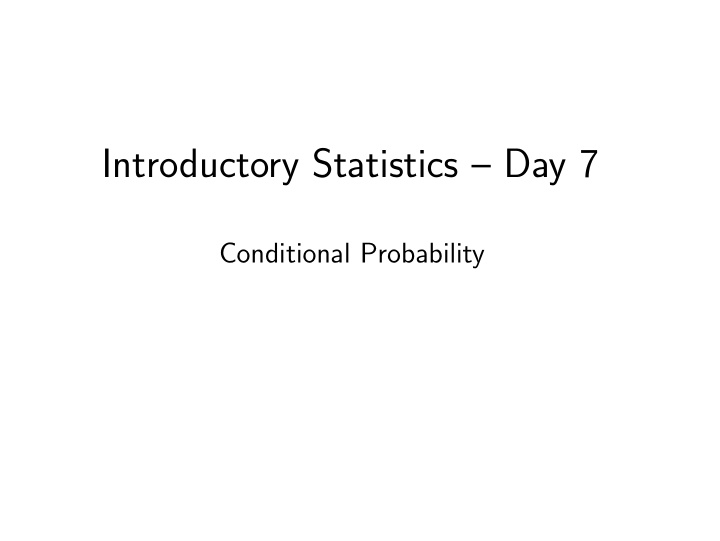



Introductory Statistics – Day 7 Conditional Probability
Activity 1: Risk Assessment In the book Gut Feelings , the author describes a study where he asked 24 doctors to estimate the following probability. Only 8 of the doctors were anywhere close! G. Gigerenzer Gut Feelings: The Intelligence of the Unconscious, Penguin Books 2008 “In your clinic the probability that one woman has breast cancer is 0.8 percent. If a woman has breast cancer, the probability is 90 percent that she will have a positive mammogram. If a woman does not have breast cancer, the probability is 7 percent that she will still have a positive mammogram. Imagine a woman who has a positive mammogram. What is the probability that she actually has breast cancer?” Make your best guess for the probability: (a) Less than 25% (b) Between 25% and 50% (c) Between 50 and 75% (d) More than 75% Justify your thinking to your neigbour.
Activity 1, continued: Assume that 100,000 women come through the clinic. Fill in the contingency table. Hint: In this example it makes sense to fill in the bottom row first. Has cancer No cancer Total Tests positive Tests negative Total A flowchart or tree can also be used to organize your thinking. For the problem described above, why is flowchart (a) a better idea than flowchart (b) for this particular problem?
What proportion of women with If a woman gets a positive test 1 5 cancer get a positive result? result, what is the chance she P ( positive | cancer ) = does not have cancer? P ( no cancer | positive ) = What proportion of women 2 without cancer get a positive What portion of tests results are 6 result? correct? P ( positive | cancer ) = P ( true negatives + true positives ) = If a woman gets a positive 3 result, is it more likely that she If a woman gets a negative 7 is from the cancer subset of the result, what is the chance she population or the non-cancer does not have cancer? subset? P ( no cancer | negative ) = Why would doctors want to 8 If a woman gets a positive test 4 keep this false negative number result, what is the likelihood she as low as possible? i.e. Why do has cancer? we want it to be so much lower P ( cancer | positive ) = than the other boxes?
Activity 2: Let’s return to the videoGamesXBoxPS3 data set from Moodle. Recreate your pivot table in Excel and answer the conditional probability questions below. M for mature T for teen E+10 E for everyone Total PS3 Xbox Total For each of the following, be careful in your selection of the divisor. Is the divisor the full count of video games, or a specific subset? If a game is selected at random, If a game is for Xbox, what’s the 1 4 what’s the chance it is rated M? likelihood it is rated E or E+10? If a game is rated M, what’s the If a game is for PS3, what’s the 2 5 chance it’s for PS3? likelihood it is rated E or E+10? If a game is rated M, what’s the Problems (2) and (3) should 3 6 chance it’s for XBox? sum to 1. Why? Problems (4) and (5) likely do not sum to 1. Why?
Activity 3: A certain disease has a prevalence of 2% in a population. Let’s assume that a test for the disease is developed and it is estimated that the test is 99% accurate. In this case, “accurate” means that if you have the disease the test is positive and if you do not have the disease the test is negative. Use your intuition to estimate the probability that a person with a positive test actually has the disease. Assume there are 10,000 people in the population. Determine the probability via the contingency table. Has Disease No Disease Total Tests positive Tests negative Total
Activity 3, continued: Now use a flowchart Find the following probabilities to organize the probability. What is the probability of a true 1 positive test? A true negative test? What is the probability of a false 2 positive test? A false negative test? What is the probability of a 3 negative test given that you have the disease? What is the probability of having 4 the disease if you test negative?
Activity 4: Binge drinking and car accidents For men, binge drinking is defined as having five or more drinks in a row, and for women as having four or more drinks in a row. According to a study by the Harvard School of Public Health, 44% of college students engage in binge drinking, 37% drink moderately, and 19% abstain entirely. Another study, published in the American Journal of Health Behavior, finds that among binge drinkers aged 21-34, 17% have been involved in an alcohol-related automobile accident, while among non-binge drinkers of the same age, only 9% have been involved in alcohol-related accidents. Create a contingency table to organize the information provided in the paragraph. Note that some labels are provided in the table, but you will need to choose the other labels before filling in the table. binge non-binge total total
Activity 4, continued. Once the table is complete, find the following probabilities. Probability that a randomly Probability that a student who 1 4 selected student is a binge drinks moderately or abstains drinker has been in an accident Probability that a randomly Probability that someone who 2 5 selected binge drinker has been has been in an accident is a in an accident binge drinker Probability that a randomly Probability that someone who 3 6 selected student is not a binge has been in an accident is not a drinker (either drinks moderately binge drinker or abstains)
Recommend
More recommend